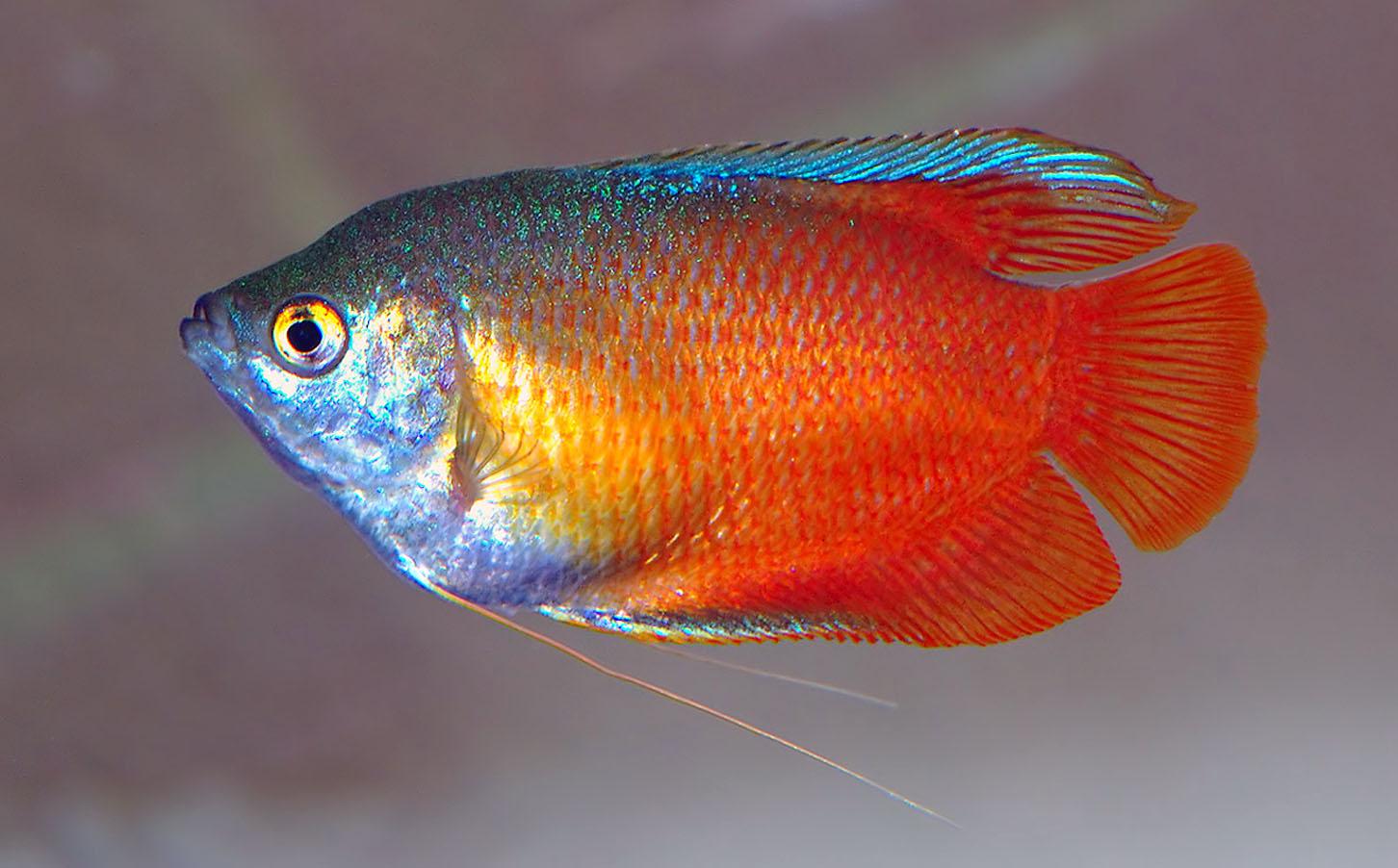Three-spot gouramiTrichopodus trichopterus
Table of Contents
Introduction
Being a member of the family Osphronemidae , the three-spot gourami(T. trichopterus) is a labyrinth fish that is capable of breathing air. It is a popular fish in the ornamental trade which have led to its establishment outside its native range. Though popular, information of T. trichopterus is rather scattered and this page aims to provide consolidated information on the biology & taxonomy of T. trichopterus.
Taxonomy
Name
| ICZN accepted name : Trichopodus trichopterus Pallas,1770 Original name in first description :Labrus trichopterus Pallas 1770 Scientific synonym(scientific names used to refer to T. trichopterus in the past)(Synonym) (Author) (ICZN Validity)* Tichogaster trichopterus (S) Bloch & Schneider, 1801, no.
(click for taxonomic history) |
Common name:(Names commonly used to refer to T.trichopterus)
Paper containing the first description of T.trichopterus:Pallas, P. S. 1770.Spicilegia zoologica quibus novae imprimis et obscurae animaliumspecies iconibus, descriptionibus atque commentariis illustrantur.Fasciculus octavus. pp. 45-46, pl. I-V Type information: (Place where the original specimen used to describe this species is kept) There is no information available on the type information and locality. |
Etymology
(why is this fish named Trichopodus trichopterus?)The genus name, Trichopodus, is composed of the Greek words ή θρίξ (thrix) which means hair and ό πούς (pous) which means foot
(Schindler,2009) while Trichopterus means hair-fin in greek, referring to the shape of the ventral fins (Ritcher,1988).
Diagnosis
(How to recognize a three-spot gourami?)Ecology
Biology
Habitat
- T. Trichopterus has a wide ecological distribution. It can withstand a large range of media ranging from ordinary freshwater, peaty and black waters, polluted waters to brackish waters.
- It is most commonly found in swamplands, rice fields,ditches ,pools and ponds that have:
- stagnant or semi-stagnant waters
- shallow waters with depth less than 2m
- bottoms with thick layer of soft mud,detritus or organic material
- high turbidity of water
- shade usually sparse or lacking
- with a good marginal growth of emergent and floating plants
- T. trichopterus is often absent from torrent streams, fast flowing streams and rivers due to the disadvantages conferred upon the fish by its laterally compressed body.
- Temperature of habitat ranges from 26 degrees Celsius to 34 degrees Celsius.
- Dissolved oxygen in the habitat can be low as T. Trichopterus is tolerant of low-oxygen environment due to its air breathing capabilities.
- Optimum pH of habitat ranges from 7.0 - 8.0 but T. trichopterus is capable of tolerating a wide range of pH from 3.7 - 9.5.
Diet
- T. trichopterus is normally a bottom feeder. They change from carnivorous feeding of zooplankton, crustaceans and insect larvae in the fry stage to algal and detritophagic feeding in the adult.
|
Breeding three-spot gourami |
|
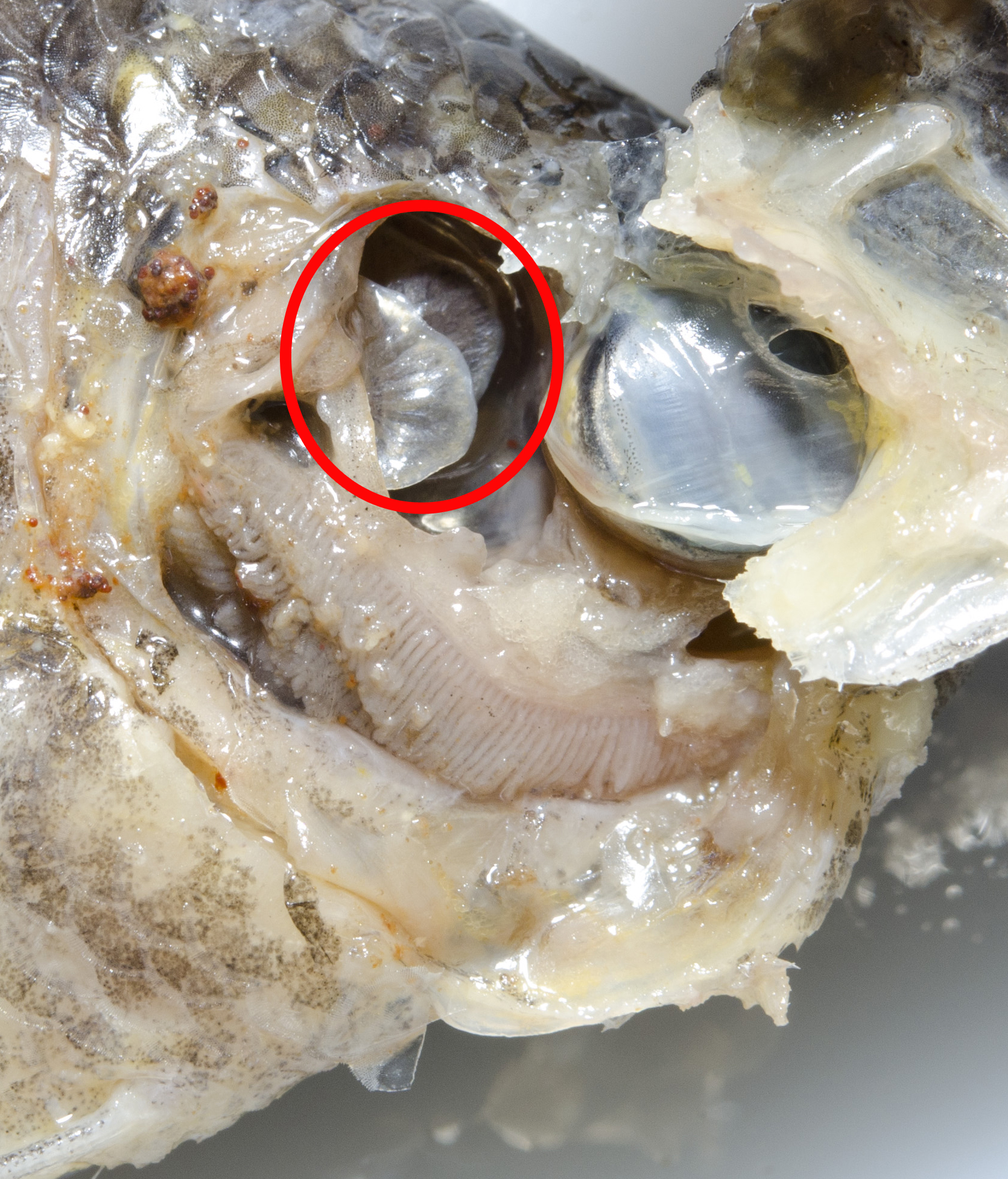 Supplementary respiratory organ of the Three-spot gourami (circled in red) Photo : Lee Ding Lun |
Distribution
| T.trichopterus can be found naturally in Southeast Asia: Singapore, Bali, Borneo, Java, Malaysia, Sumatra & in the Mekong basin in Yunnan, Thailand, Laos, Cambodia ,Myanmar(Burma) and Vietnam. In Singapore, it has been observed at Sungei Ayer Tawar (1958), Sungei Seletar, Nee Soon Rifle Range (1958), Serangoon (1898,1964), Jervoise Road (1912), Woodleigh (1934), Sungei Tengeh (1963),Sungei Kangkar (1963), Sungei Kallang, outlet from Peirce Reservoir (1964), Sungei Seletar, outlet from Seletar Reservoir (1964), Somerset Road, R. Hanitsch(1912).( Alfred E. R.,1966), Kalllang river (Tan et. al, 2010), Sungei Buloh Wetland Reserve & Seletar Wet-gap (2011, Observed by Low Bi Wei). Being a popular and intensively marketed tropical aquarium fish species, T. trichopterus has been introduced by accident or intentionally released into the freshwater habitats of many countries.There have been evidence of established populations in western Ghat in India (Molur, 2008),Philippines(Juliano et al. 1989), Taiwan(Shen 1993), Papua New Guinea(Allen,1991), Southern Africa (FAO, 1997), South America(Welcomme, 1988), the Dominican Republic (Lever,1996) and Queensland, Austrailia (Ringwood,2009). There were also sightings in Florida (Fuller et al. 1999) and Canada (Crossman 1984), but without evidence of establishment. |
View Distribution of Trichopodus trichopterus in a larger map |
Sub-species of T. trichopterus
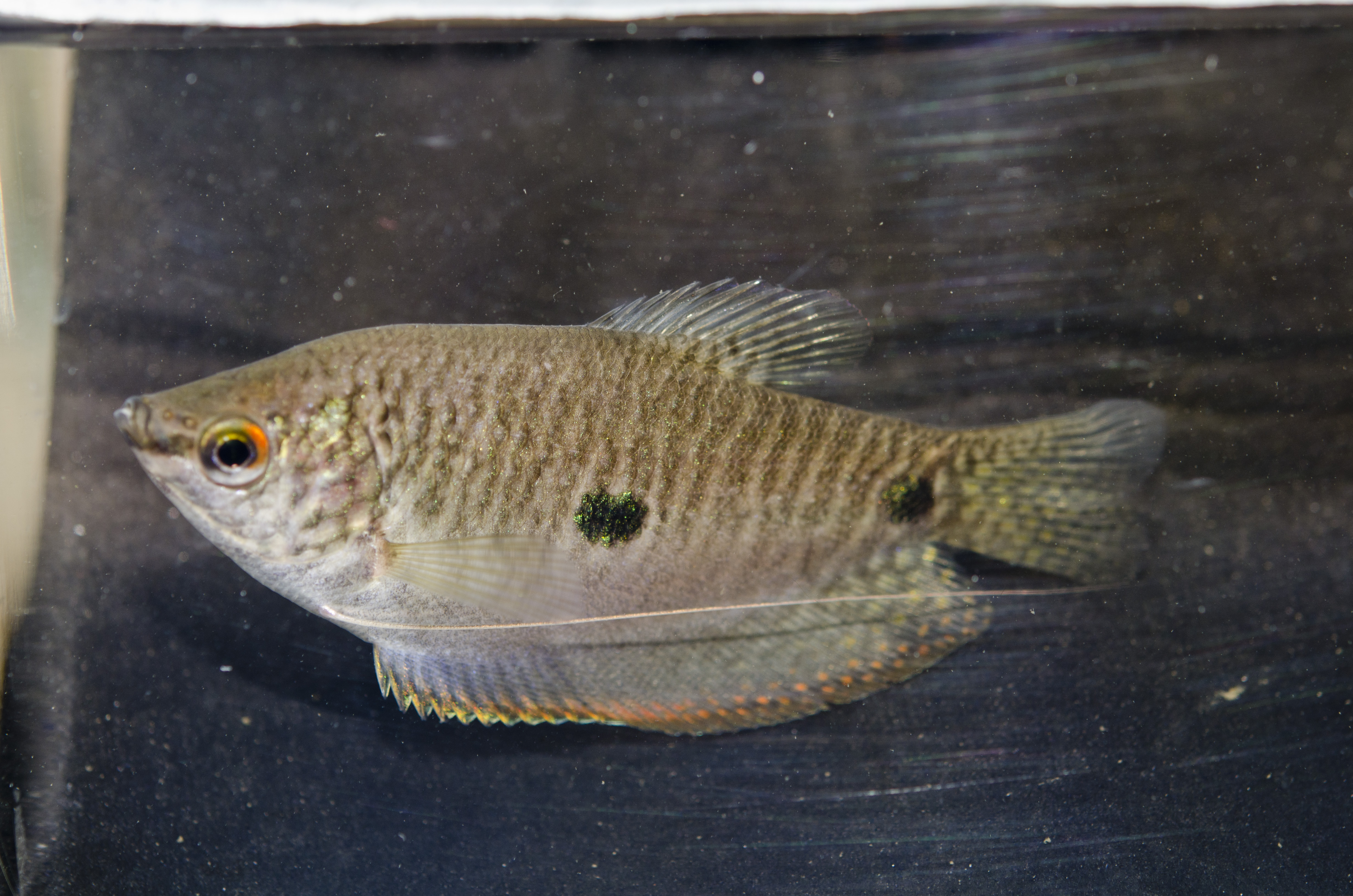 T. tricopterus trichopterus(wild) Photo: Lee Ding Lun |
Blue gourami( T. trichopterus sumatranus Ladiges, 1933) |
 Silver gourami (Mutation of T. trichopterus sumatranus)(Aquarium Breed) Photo: http://freshaquarium.about.com/od/gourami/ig/Gourami-Gallery/Three-Spot-Gourami.htm |
Cosby gourami (Mutation of T. trichopterus sumatranus)(Aquarium Breed) |
| *As no paper or article has been found to support the validity of T. trichopterus sumatranus as a sub species at the moment, due caution should be taken when using the name.* |
Gold gourami (Mutation of T. trichopterus sumatranus)(Aquarium Breed) |
Environmental Impacts
Despite the existence of multiple established populations across the world, the ecological impacts of this species have not been adequately explored and evaluated.However, It has been suggested that T. trichopterus is capable of competing with the native fish population for food and space as they are able to dominate areas, which the natives are not able to, due to their high fecundity , their ability to breathe air and their tolerance to varying pH levels , temperature and salinity.In Queensland, Australia,T. trichopterus can only be kept in aquariums, but cannot be released. They cannot be used as bait, live or dead. If they are caught in the wild they must not be returned to the water. Penalties up to $200,000 apply(Ringwood,2009).
In Kerala, India, T. trichopterus is considered an invasive species and is thought to be potentially harmful to native ornamental fishes there.
(Krishnakumar et al., 2009)
In 2009, Geheber et al.(2010) collected T. trichopterus from a small pond near the northern coast of Jamaica in June. The collection represents the first documentation of this species in Jamaica.
Human uses
- Food fish in parts of Malaysia, Thailand, Indonesia and Cambodia.
- Aquarium fish trade
Conservation Status
IUCN Red list status: Not evaluated
The Singapore Red Data Book: No Record
Although the abundance of T. trichopterus has not been evaluated, Alfred (1996) mentioned that T. trichopterus is common and widely distributed in Singapore.
Threats faced by T. trichopterus
Although there are no know threats to T.trichopterus globally or locally in Singapore, native populations of T.trichopterus in Singapore are facing a reduction in range due to rapid loss of habitats & habitat degradation over the years.
Taxonomic Details
Description
(Morphological features of T. trichopterus that can be used for identification purpose)
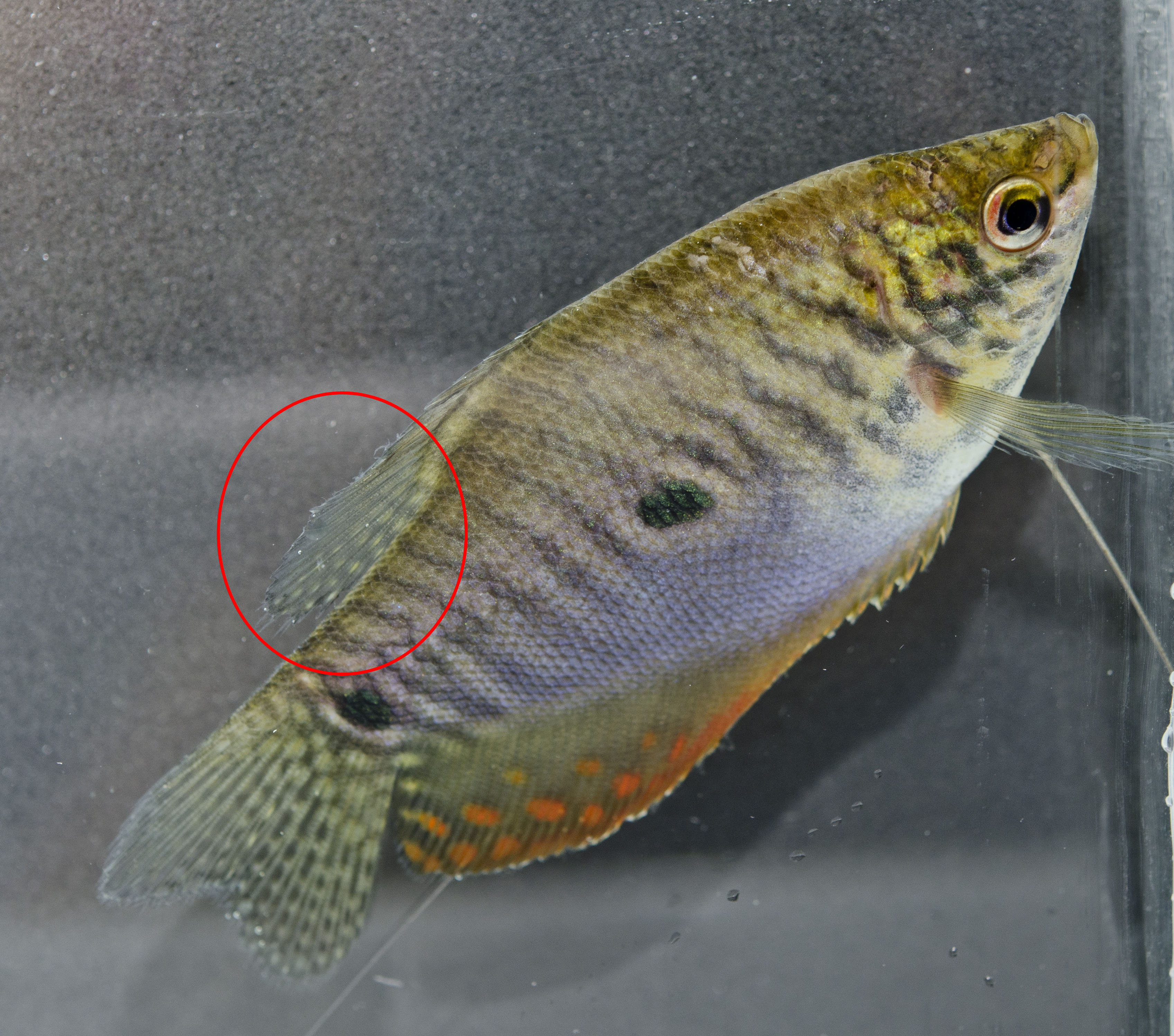 Male T. trichopterus. (Diagnostic dorsal fin circled in red; click to enlarge) |
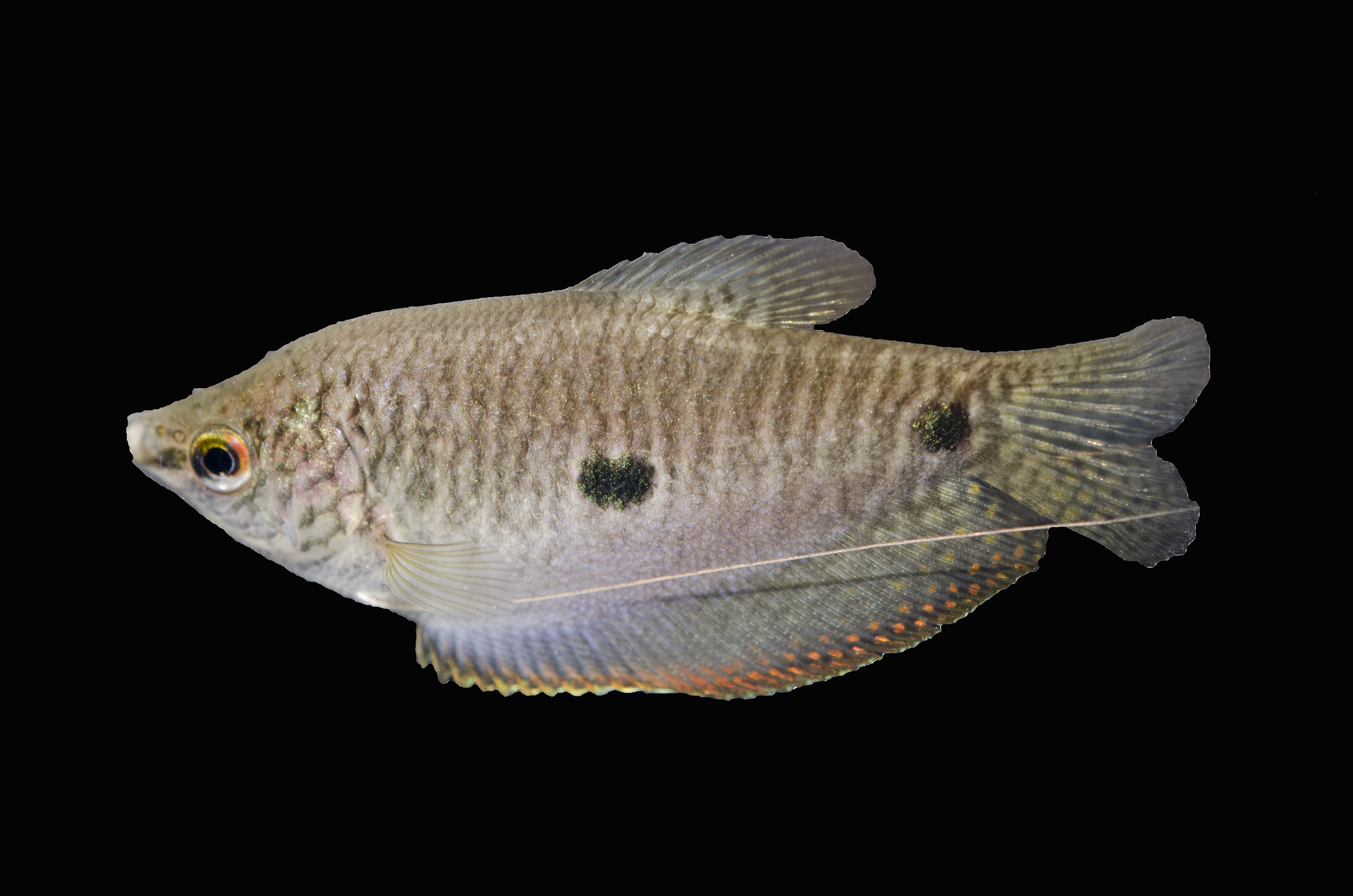 Photo:Lee Ding Lun 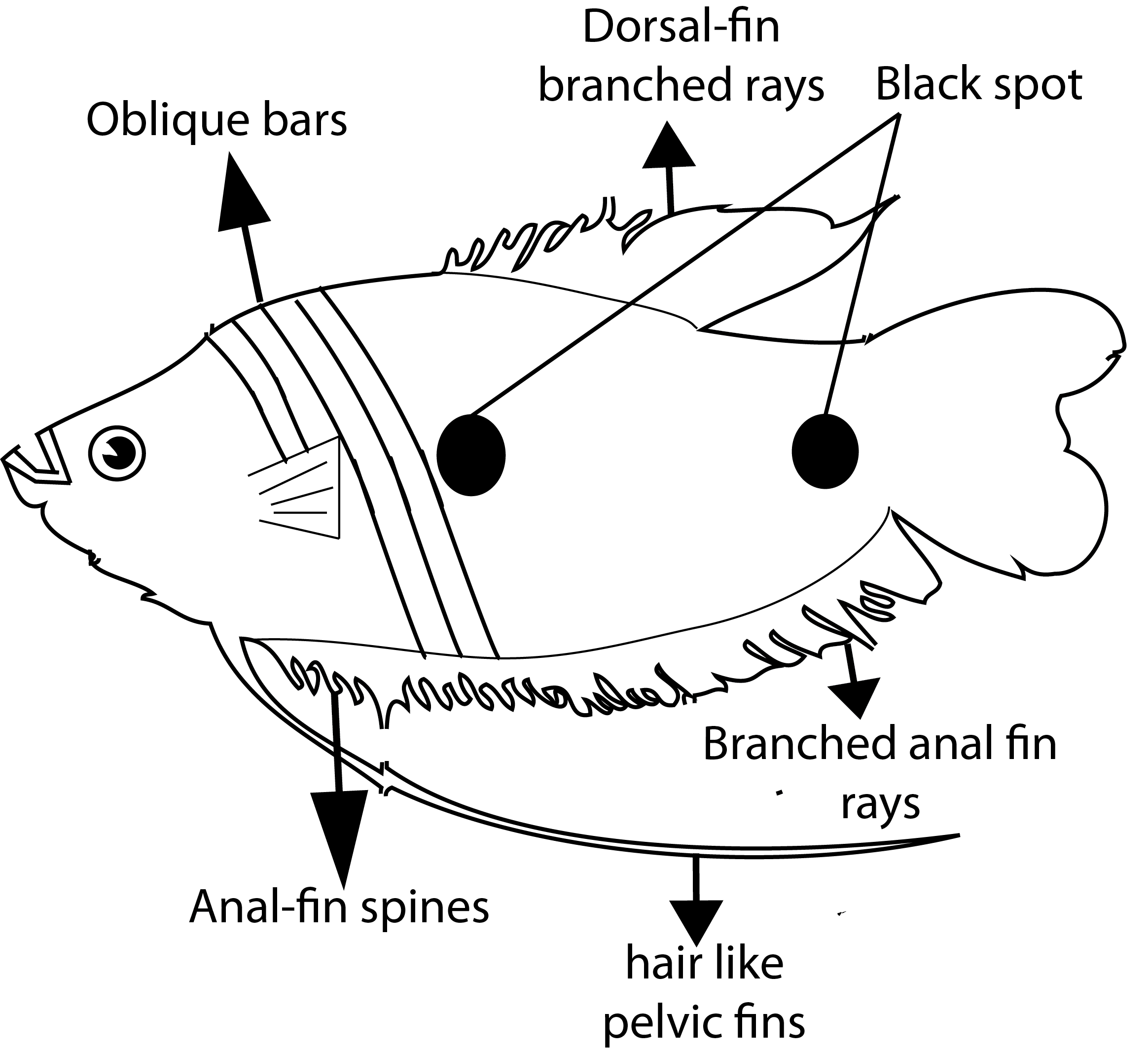 Photo: Lee Ding Lun  Alcohol preserved specimen, Sungei Buloh Wetland Reserve. Photo:Lee Ding Lun 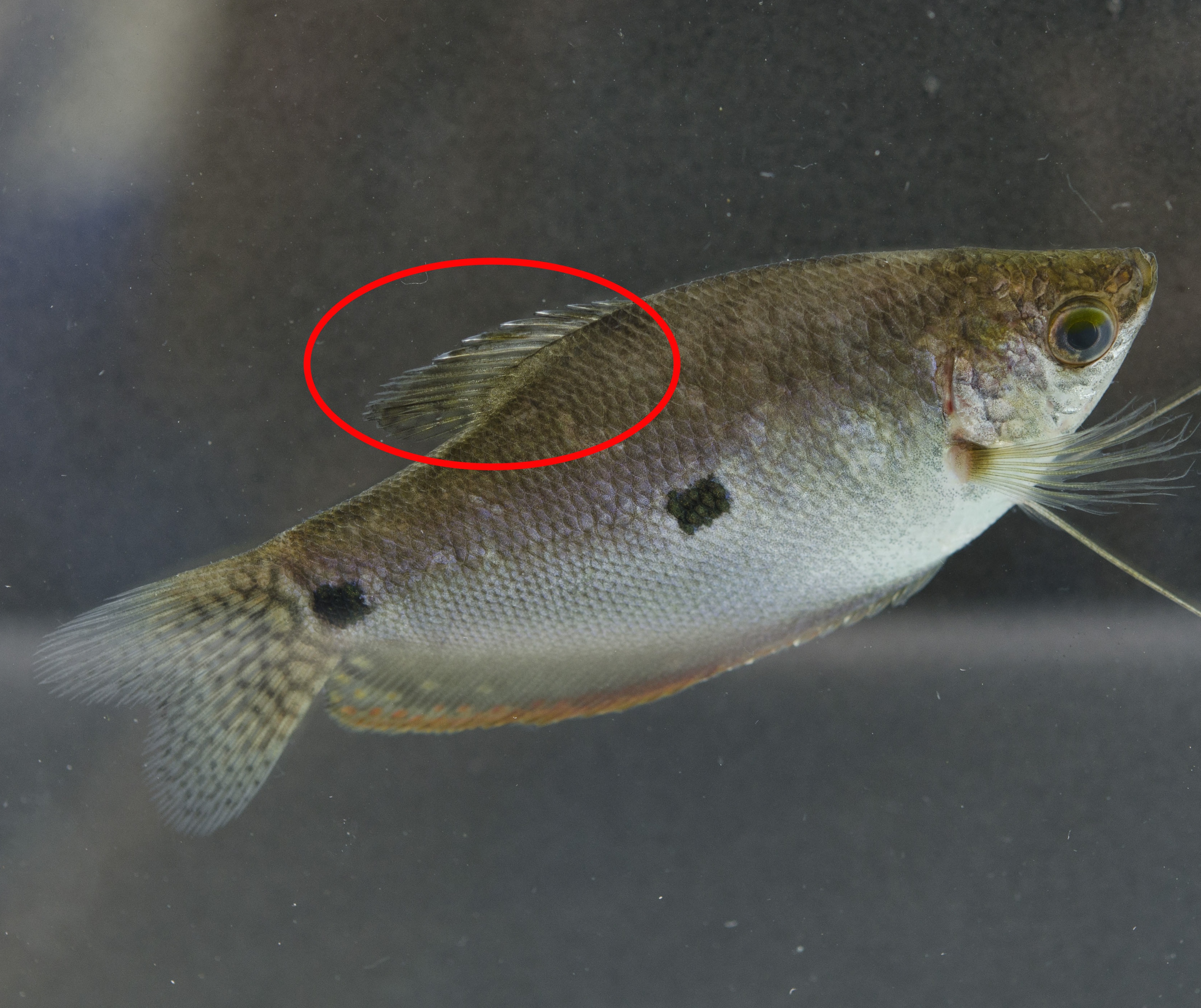 Female T. trichopterus (Diagnostic dorsal fin circled in red; click to enlarge) Female T. trichopterus (Diagnostic dorsal fin circled in red; click to enlarge) |
Taxonavigation and history
| Taxonavigation (Currently accepted relative postion of T.trichopterus in higher order taxon) Kingdom: Animalia Linnaeus , 1758 Phyllum: Chordata Bateson,1885 Class: Actinopterygii (Ray-finned fish) Klein,1885 Order: Perciformes (Perch-like) Family: Osphronemidae Bleeker,1859 Genus: Trichopodus Lacepede,1801 |
Taxonomic History (Changes in the genera of trichopterus) The genus Trichopodus was formed by Lacepede (1801) for the two species-group taxa T. mentum and Labrus trichopterus Pallas (1770) but no type species was determined then. In 1831, Cuvier included Labrus trichopterus Pallas, 1770 as the single species for Trichopodus . In 1917, unknowing of the earlier description by Bleekers(1879) Jordan assigned Trichopodus mentum Lacepede as the type species for Trichopodus and Trichogaster fasciatus Bloch & Schneider(1801) as the type species for Trichogaster. Until 1923, the four small gouramis were classified as Trichogaster while the larger gourami as Trichopodus. In 1923, Myers contested the assignment by Jordan and interpreted Cuvier's boundary of Trichopodus (thus also for Trichogaster incorrectly). Since MYERS (1923) assumed that Trichogaster Bloch & Schneidler is the senior synonym of Trichopodus Lacepede, he synonymnised both as Trichogaster and a new genus Colisa was erected for the four small gourami In 1997, Derijist pointed out the earlier description by Bleekers (1879) and in 2004 Britz made Colisa obsolete ,returned the 8 species to their previous genera and revived genus Trichopodus at the same time. However, the proposed changes were not used in subsequent literature. In 2008 ,Töperfer and Schindler identified the change but it was only in 2009 when Töperfer and Schindler published a paper reaffirming Trichopodus as a valid genera with the type species as Trichopodus trichopterus. Extracted from Töperfer & Schindler (2009) |
Phylogenetic position
(Relative phylogenetic position of T. trichopterus among related fishes)Based on the phylogenetic tree, we can see that members of genus Trichopodus, previously known asTrichogaster, forms a monophylectic group and is a sister taxa of genus Trichogaster, previously known as Colisa.The closest relative to T. trichoptersus is T. pectoralis (Snake-skin gourami). |
 Abstracted from Rüber et al.,2005 (Click for more information)Phylogenetic analysis done based on a Bayesian phylogenetic approach on mtDNA60. (Permission granted - License Number: 2783980703832 ) |
ReferencesAlfred E. R.,1996.The fresh-water fishes of Singapore. ZOOLOGISCHE VERHANDELINGEN 78:52.Allen GR (1991) Field guide to the freshwater fishes of New Guinea. Christensen Research Institute, Madang, Papua New Guinea Bleeker, P.,1845.Bijdragen tot de geneeskundige Topographie van Batavia. Generisch overzicht der Fauna. Natuur-en Geneeskundig Archief voor Neȇrlandsch Indië v. 2 (3): 505-528. Britz, R. 2004. Why Colisa has become Trichogaster and Trichogaster is now Trichopodus.AAGB Labyrinth 136: 8–9 Cole B.,C. S. Tamaru & C. Brown,1997.A manual for comercial production of the gourami,Trichogaster trichopterus: a temporary paired spawner.Cener for tropical and subtropical aquaculture publication number 135. Degani,G.,1989. The effects of temperature, light, fish size and container size on breeding of Trichogaster trichopterus. Bamidgeh 41(2):67-73 Derijst, E., 1997: Nota over de geldigheid van de genusnamen:Trichogaster BLOCH & SCHNEIDER, 1801; Trichopodus LACEPÈDE, 1801; Polyacanthus CUVIER, 1829 en Colisa CUVIER, 1831 (Perciformes: Belontiidae); met commentaar over de publicatiedata van de werken van BLOCH & SCHNEIDER en van LACEPÈDE, beide verschenen in 1801 en over het auteurschap van de genusnaam Colisa. – Aquariumwereld, 50(9): 217–226. FAO (1997) Food and Agriculture Organization of the United Nations (FAO) FAO Database on Introduced Aquatic Species, Rome, Italy. Geheber A. D., D. M. Caleb & R. P. Kyle, 2010.First record of the non-native three spot gourami, Trichogaster trichopterus (Pallas 1770) (Teleostei: Osphronemidae) in Jamaica.Aquatic Invasions 5, Supplement 1:13-16. Günther, A.,1861.Catalogue of the fishes in the British Museum. Catalogue of the acanthopterygian fishes in the collection of the British Museum. 3. Gobiidae, Discoboli, Pediculati, Blenniidae, Labyrinthici, Mugilidae, Notacanthi. London. Catalogue of the fishes in the British Museum. Horst Linke,1992.LABYRINTH FISH: The Bubble-Nest-Builders.Tetra-press.Germany.ISBN 0-46798-16071-7 Inger R. F. & P. K Chin,2002.The Freshwater fishes of north Borneo.Natural history publications(Borneo).ISBN 983-812-070-7 JORDAN, D. S. (1917): The genera of fi shes, from Linnaeus to Cuvier, 1758–1833, seventy-five years with the accepted type of each. – Stanford University, California, Juliano R. O., Guerrero R. D., Ronquillo I.,1989. The introduction of exotic aquatic species in the Philippines. In: De Silva SS (ed) Exotic aquatic organisms in Asia. Asian Fisheries Society, Spec. Publ. Manila, Philippines,pp 83-90 Ringwood G.,2009.Three spot gourami.Primary industries and fisheries, Queensland government.http://www.dpi.qld.gov.au/28_14162.htm. Accessed on 30/10/2011. Kottelat M.,2001.Fishes of Laos.WHT Publication(Pte) Ltd. ISBN 955-911-25-5 |
Krishnakumar, R. Raghavan , G. Prasad, A. Bijukumar, M. Sekharan, B. Pereira and A.Ali. When pets become pests – exotic aquarium fishes and biological invasions in Kerala, India. Current Science 97(4). LACEPÈDE, B.G.E. (1801): Histoire naturelle de poissons. – Vol. 3, Paris, 558 pp. Lever C (1996) Naturalized fishes of the world. Academic Press, California, USA Molur, S., Smith, K.G., Daniel, B.A. and Darwall, W.R.T. (Compilers). 2011. The Status and Distribution of Freshwater Biodiversity in the Western Ghats, India. Cambridge, UK and Gland, Switzerland: IUCN, and Coimbatore, India: Zoo Outreach Organisation. Myers G. S., 1923.Further notes on Anabantids.Copeia 124:111-113. Pallas, P. S. 1770.Spicilegia zoologica quibus novae imprimis et obscurae animalium species iconibus, descriptionibus atque commentariis illustrantur. //Fasciculus octavus//. pp. 1-54, pl. I-V Pinter, H.,1986. Labyrinth Fish. Barron's Educational Series, Inc., ISBN 0-8120-5635-3 Rainboth W. J.,1996.Fishes of the Cambodian Mekong.Food and Agriculture organization ot the United Nations.ISBN 92-5-103743-4 Ritcher H. J.,1988. Gouramis and other Anabantoids.T.F.H. Publications,Canada. ISBN:0-86622-941-8 Rossmann , K.-H. 2008. Neue Namen für die Fadenfische? Der Makropode 30(3): 79–80 Rüber L.,R. Britz & R. Zardoya, 2005. Molecular Phylogenetics and Evolutionary Diversification of Labyrinth Fishes (Perciformes: Anabantoidei).Syst Biol55(3): Seale, A.,1910. New species of Philippine fishes. The Philippine Journal of Science Section A v. 4 (no. 6): 491-543, Pls. 1-13. Shen S. C., 1993. Fishes of Taiwan. Department of Zoology,National Taiwan University, Taipei, pp 960 Schindler, I. 2009. On the spelling of the Species name of the genus Trichogaster (Formerly Colisa) and Trichopodus. Der Makropode31(1): 5–9 Tan H. H. & K. L. Ng ,Peter, 2005.The labyrinth fishes(Teleostei:Anabantoidei) of Sumatra, Indonesia.Raffles Bulletin of Zoology// supplement 13:115-138 Tan C. K.,1969. Some biological studies on the two spot gouramy Trichogaster trichopterus(PALLAS). Master Thesis. National University of Singapore. TÖPFER J. & I. SCHINDLER, 2009.On the type species of Trichopodus (Teleostei: Perciformes: Osphronemidae).Vertebrate Zoology59(1): 49-51. Töpfer, J. 2008. Lacepède – 2. Teil: Seine Labyrinthfischgattungen Osphronemus, Trichopodus und Macropodus sowie die Gültigkeit der Namen. Der Makropode 30(2): 41–52 Welcomme R. L.,1988.International introductions of inlandaquatic species. Food and Agriculture Organization of the United Nations (FAO). FAO Technical report No 294, 318 pp |
Discussion area
| Subject | Author | Replies | Views | Last Message |
|---|---|---|---|---|
| No Comments | ||||
